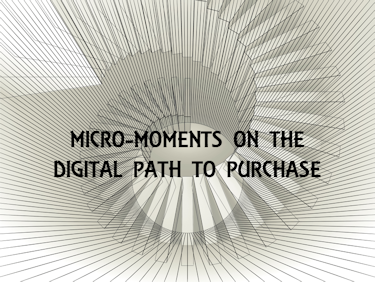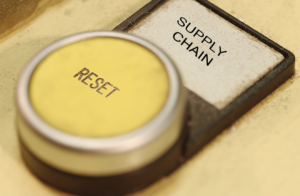Author H. Jackson Brown, Jr., has stated, “Nothing is more expensive than a missed opportunity.” It’s an adage brands should take to heart. The challenge today is that opportunities on the consumer digital path to purchase can be missed faster than the eye can blink. Those opportunities are called “micro-moments” — a term coined by Google in 2015 — and brands need to be ready when they occur. Sridhar Ramaswamy, a former Senior Vice President of Ads & Commerce at Google, writes, “Consumer behavior has changed forever. Today’s battle for hearts, minds, and dollars is won (or lost) in micro-moments — intent-driven moments of decision-making and preference-shaping that occur throughout the entire consumer journey.”[1] Heather Mueller (@heathermueller) agrees with Ramaswamy that the path to purchase has changed forever. She writes, “The days of a linear, clear-cut path to purchase are long gone. Today’s consumers are working their way through a far more complex web of small, smartphone-enabled steps — each one inching them toward the ‘buy now’ button over the course of many weeks or months. … Google refers to these steps as ‘micro-moments,’ and says they are having some tremendous impacts on digital marketing. Ready or not, micro-moments are transforming marketing as we know it.”[2]
What are micro-moments?
Mueller adds, “Micro-moments occur when people reflexively turn to a mobile device to explore, discover, research, and buy. They are high-intent moments when preferences are shaped and decisions are made.” Ramaswamy observes that these “fragmented interactions … now occur instantaneously.” He adds, “There are hundreds of these moments every day — checking the time, texting a spouse, chatting with friends on social media. But then there are the other moments — the I want-to-know moments, I want-to-go moments, I want-to-do moments, and I want-to-buy moments — that really matter. We call these ‘micro-moments,’ and they’re game changers for both consumers and brands.” Brands can only take advantage of these micro-moments if they are present when they occur. If brands aren’t there, it’s a missed opportunity and it can be costly. Jessica Neville, a senior strategist at Dagger, writes, “Online searches and other moments that lead to a mobile or digital action in a consumer’s daily life may seem trivial, but they can hold large opportunities for brands.”[3]
Jonathan Lacoste (@lacostejonathan), Co-founder and President of Jebbit, explains, “The philosophy behind micro-moment marketing is that in the world today, consumers are bombarded by content, ads, offers, emails, texts, tweets, push notifications and everything else imaginable. … It’s important to objectively realize that your brand or product isn’t the center of your consumer’s world. In fact, most of the content we produce as marketers might be perceived as an interruption to a consumer as they’re going about their day. Thus, the key of micro-moment marketing is to embrace the idea that you have but a few seconds to capture the attention of your target consumer. In those nanoseconds, brands are challenged to convey a clear and concise message that is relevant and of interest to the consumer.”[4] Lisa Gevelber, Vice President of Marketing for the Americas at Google, asserts, “[Consumers] expect an immediate answer in the moments they want to know, go, do, and buy.”[5] She adds, “The concept of micro-moments [is] perhaps as truthful, observable, and relatable a consumer behavior trend as any marketer could wish for.”
Taking advantage of micro-moments
In order to take advantage of micro-moments, you need to identity such moments. Neville asks, “Can you anticipate those moments and take advantage of them to shape consumer decisions?” As Ramaswamy noted above, those moments include I want-to-know moments, I want-to-go moments, I want-to-do moments, and I want-to-buy moments. Neville writes, “Begin by identifying these customer intentions and craft specific content responses to solve real, everyday problems, no matter how small.” Where will consumers find that content? Most likely on their smartphones. Neville explains, “In our mobile-first world, people increasingly turn to their smartphones for every direction, purchase, and answer possible. And when they do, they probably have a specific need and an expectation of finding answers easily and quickly.” Gevelber adds, “[Looking for answers on smartphones has become] an entrenched behavior — micro-moments are only multiplying. People can’t remember what it was like to not be able to learn, do, or buy things when the need struck by reaching for the device in their pocket.” Ramaswamy adds, “[Micro-moments] are intent-rich moments when decisions are made and preferences shaped. In these moments, consumers’ expectations are higher than ever. The powerful computers we carry in our pockets have trained us to expect brands to immediately deliver exactly what we are looking for when we are looking. We want things right, and we want things right away.”
Lacoste insists good micro-moment marketing must provide value to consumers. He explains, “[Micro-moments marketing] starts with content that delivers value and can be consumed quickly. Industry trends show that content marketers and teams are putting more emphasis on the value of content rather than the production quality — meaning that in a world of selfies and user-generated content, everything you share with consumers doesn’t need runway level production.” He adds, “The second important tactic of micro-moment marketing is the idea of a ‘value-based exchange.’ Why should a consumer spend time engaging with your brand or content? What value do they get out of that interaction? If each interaction does not offer something of value, whether it is insights, knowledge, or even offers, discounts or exclusive experiences, then consumers are unlikely to engage as frequently.” Mueller calls this thinking small. She writes, “Most marketers have gotten good at creating content for the ‘big’ moments, but spend far less time on the little steps that lead the way.”
Concluding thoughts
There are so many potential micro-moments, brands might consider micro-moment marketing a daunting task. Neville begs to differ. She writes, “The multitude of micro-moments is actually a good problem to have, providing more opportunities than ever for brands to be there for customers as a reliable and useful resource.” Consumers are actually looking for help in those micro-moments. Gevelber explains, “People today want to be empowered to make the right decision, big or small — and they’re turning to their phones for advice to guide them.” Ramaswamy bluntly states, “The successful brands of tomorrow will be those that have a strategy for understanding and meeting consumers’ needs in these micro-moments.”
Footnotes
[1] Sridhar Ramaswamy, “How Micro-Moments Are Changing the Rules,” Think with Google, April 2015.
[2] Heather Mueller, “What Are Micro-Moments?” Formstack Blog, 23 May 2019.
[3] Jessica Neville, “Are Marketers Missing Opportunities to Seize Consumer Micro-Moments?” MarketingProfs, 4 May 2017.
[4] Jonathan Lacoste, “WTF is Micro-Moment Marketing?” Inc., 22 January 2016.
[5] Lisa Gevelber, “Micro-Moments Now: 3 new consumer behaviors playing out in Google search data,” Think with Google, July 2017.





